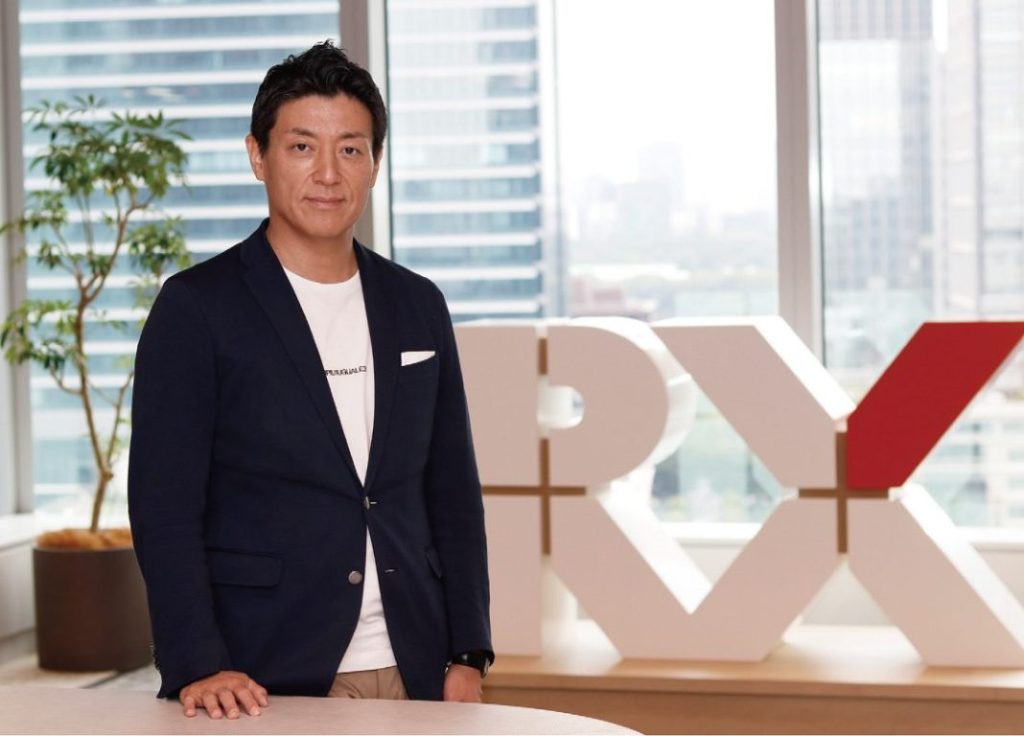(This article is a reprint of an excerpt from the June 15, 2023 issue of “Trade Fair and Exhibition News” #900.)
Since the Covid-19 pandemic, the exhibition business has been going through a period of major transformation. Therefore, we spoke with President Takeshi Tanaka of RX Japan, a leading Japanese exhibition organizer, to learn about his vision for the near future.
―The determination to continue leading the race―
Thoughts on moving to the new RX Central Station office
In April of this year, we moved our office to the newly completed Tokyo Midtown Yaesu building in front of Tokyo Station. The new office’s concept in “RX Central Station.” Situated in view of Japan’s largest “RX Central Station”, Tokyo Station, it represents the idea that not only RX employees but everyone involved with our company will gather here to embark towards the future.
Furthermore, the office relocation, in addition to being a milestone on our way to the future, also demonstrates our determination to continue to lead the way in the development of the exhibition industry. Currently, the exhibition industry is still not as prevalent in society as other big industries, which makes it difficult to gather good talent. I wish to break free from this status quo. Since assuming the role of president in 2019, I have been working on one initiative at a time and taking on challenges that I believe are necessary, despite the effects of the pandemic. The move to the new office is the first step in embodying my ideas, and this is simply the beginning of what is to come.
Seeking growth ~ A changing business culture
My goal is not to change the existing business culture. I believe that if I continue to desire to make the company better and to improve the company’s performance, then the business culture will naturally change. We have always been at the top of our industry, and I have been a part of it, having worked on many exhibitions and accumulated results. However, when I took over as president, I thought that it would be boring to add to our previous achievements like 1 + 1 = 2, 2 + 1 = 3…
Rather than repeating ourselves and doing what is expected, I want to undertake new challenges and increase our growth rate to higher than ever before. To this end, I have decided to leave a number of duties to our employees in the field. If I interfere in the field, employees will wait for orders. I’ll be anxious at first, but I’ll become able to properly trust them. In doing so, I will stop at advice and leave the rest to them. This way, the field employees, who are the exhibition creators, are now responsible for seeing it through. Aside from exhibitions, I actually entrusted the office relocation entirely to a project team consisting mainly of field employees, and I, myself, was even looking forward to its opening.
I believe that my role is ultimately to facilitate the growth of the company and pass the baton to the next generation. Our company’s business conduct is, for example, simplifying the approval process and creating an atmosphere in which it is easy to express opinions. We are fully committed to building a work environment that is easy for employees to thrive in, such as an evaluation system and encouraging motivation that leads to successful exhibitions.
―The meaning of continuing to invest in the future―
Keeping up with changes in attendees
The platforms that make our lives easier have spread, making not only the business environment but also daily life more convenient. The speed of human traffic and information transmission will likely increase exponentially in the coming years.
In this sort of situation, as a company that will continue to launch exhibitions, we must always stay one step ahead. Instead of creating a desired platform, it is important for us to work ahead, propose a structure that calls out, “Over here, everyone!” and bring people to us. If we do not do this and keep organizing exhibitions with the same theme over and over again, it will start to feel like a class reunion, and visitors will eventually no longer have a reason to attend those exhibitions.
Reception area ~ Automation succeeds in saving time
10 years ago, at an exhibition that I was in charge of, the average time at reception per visitor was 1 minute and 30 seconds. Attendees would come to the registration counter with 2 business cards, then a staff member would staple one business card to the invitation ticket, place the other in a badge holder, and ask the attendee to fill out a questionnaire if they had not already completed it. This resulted in a line of people waiting to be admitted.
These lines would take up visitors’ time and lead to lost business opportunities for exhibitors. Even if an attendee could only stay at the venue temporarily for 2 hours, they might have to wait in line for up to 30 minutes if there were 20 people ahead of them at the reception counter. This calculation induces a matching loss of 25%.
In order to solve this problem, we strived to develop automation and digitalization of the reception counter, and we have finally brought our idea into reality. Automation has not only reduced reception time, but also the amount of trouble caused by irritated attendees, not to mention increased field work efficiency. However, this is merely a reduction in wait time, and I am not at all satisfied. Therefore, we have begun to introduce automation at some exhibitions, but…
(The rest of the interview can be read in Japanese in the back number of “Trade Fair and Exhibition News” Electronic Version)

